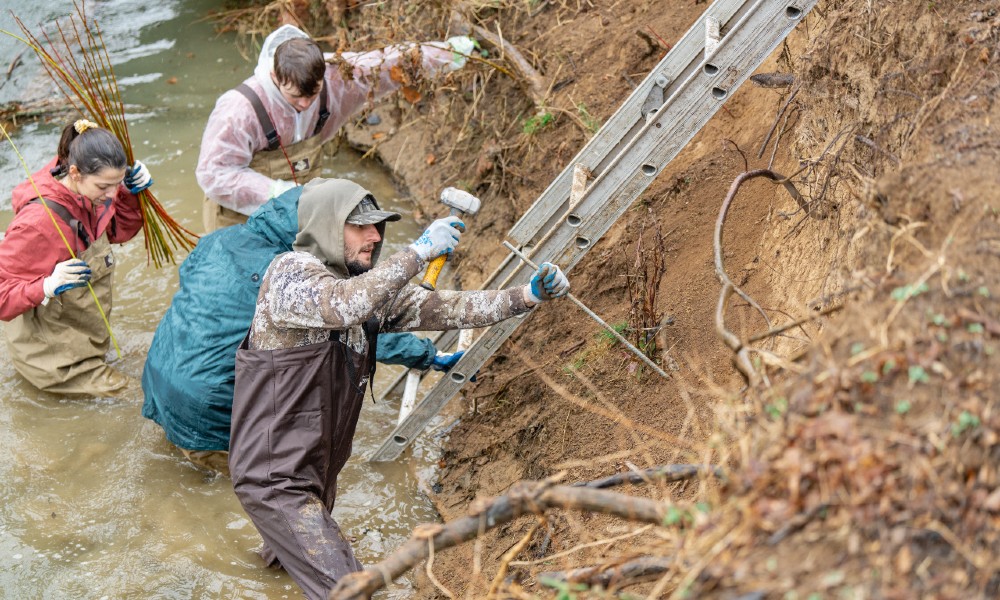Planting the future: ISAT students restore riverbank
News
As you travel south along Port Republic Road and turn onto Alumnae Drive, you’ll discover the James Madison University Farm — a 30-acre hidden gem. Featuring a historic home built in 1848 and 1,000 feet of river frontage, the farm serves as a weekend camp, event venue, and community space.
Despite its beauty and utility, the farm faces a significant challenge: riverbank erosion. “We are seeing a loss of stream bank because of this,” explained Carole Nash, Geography and Integrated Science and Technology professor. “It’s a natural process but also a problem because we lack trees and limited vegetation on the banks. Without the support of roots, the soil is vulnerable to water erosion.”
Nash highlights the multifaceted challenges arising from erosion. “We’re not only losing land — likely about 10 feet of stream bank over the last decade — but increased sediment is going into the river, leading to water quality issues.”
To address this problem, ISAT majors Reggie Wilcox and Patrick DeHarde dedicated their capstone projects to stabilizing the stream bank and floodplain, combating erosion.
Wilcox’s project focused on establishing a riparian meadow in the floodplain and devoted considerable time to researching 28 plant species suitable for the environment and strategizing future space management. “As these plants flourish, their roots will help stabilize the soil and prevent further erosion,” Wilcox explained. “With assistance from JMU’s Facilities Management, I monitored the seed mixes that included sunflowers, asters, black-eyed Susans, wildflowers, and an assortment of grasses.”
Despite the seed mixes, more must be done to combat stream bank erosion. Traditional engineering solutions involve cutting back the slope with heavy equipment, but Nash followed the recommendations of colleagues and staff members from Facilities Management to propose a different approach — planting trees. Recognizing the critical role of vegetation in stabilizing the soil, Nash advocated for a unique method called live staking to combat erosion in a cost-effective and environmentally friendly manner.

“Live staking involves inserting small branches, or ‘whips,’ from fast-growing native species into the soil at angles,” Nash explained. “This non-invasive method allows the branches to establish root systems and stabilize the stream bank.”
DeHarde is developing a monitoring system to assess the effectiveness of live staking and monitor biodiversity along the stream bank. He will continue to collect data through his senior year, providing valuable insights into the restoration efforts’ success and the area’s ecological health.
For Wilcox and DeHarde, engaging the community in the live staking process was integral to the success of the stream bank project. By inviting JMU community members to participate in planting and restoration efforts, the project fosters a sense of shared responsibility, deepening their connection with the environment and the farm.
In February, JMU Facilities Management and student volunteers from various organizations gathered at the farm to plant branches along the stream bank. “We had a great turnout. So many people were supportive,” Wilcox recalled.
Geography major Elena Finelli shared, “I love any chance to get out and get my hands in the dirt.” Nash added, “There’s a powerful educational component here, demonstrating the university’s commitment to environmental stewardship and hands-on learning.”
With the meadow planted and branches taking root along the stream bank, the focus now shifts to monitoring the progress. Wilcox envisions a future where the bank is stabilized and thriving. “Part of my goal was to leave behind a greater sense of environmental stability and something that I had a hand in protecting.”
